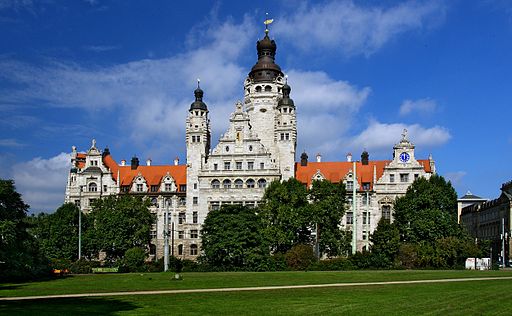Leipzig

Leipzig is a city full of culture and a city where many fairs are held. Bach, Wagner, Lenin, Rosa Luxemburg, Goethe. These celebrities have all left footprints in Leipzig. Leipzig is also a very much green city and we can cross it from north to south without leaving the woods.
In 2015, Leipzig celebrates its 1000th anniversary! Throughout the year festivals, exhibitions, guided tours and concerts will take place to celebrate it. Discover them by clicking on www.leipzig2015.de.
What should you see ?
The St. Thomas Church, Thomaskirche, is a beautiful church. This is the church where Bach was choirmaster and musical director. This is where he is buried. If you have the opportunity, you should absolutely listen to a concert of the choir of this church, the Thomanerchor. This is an excellent choir, singing especially Bach.
The Bach Museum, das Bach Museum. To hear the music of Bach and discover musical instruments from the period when Bach lived, but also to see manuscripts, portraits, pieces of furniture and clothes of that period. Oddly, the museum is not located in the house where Bach lived, but in the house of one of his friends ... Bach house is opposite the museum!
The Old Town Hall, das Alte Rathaus is a great achievement of the Renaissance. Today the Museum of History of the City of Leipzig is in there.
The New City Hall, das Neue Rathaus
A restaurant, Auerbachs Keller is one of the restaurants where you really should eat. It has existed for 490 years!
The lighthouses, Leuchtturme mit Gewandhaus.
Three times a year, the ateliers of the Spinnerei open their doors to the public. They are highly popular among the residents of Leipzig. The Spinnerei is a former industrial area, where cotton was produced until 1992. Their halls were well preserved. They now house ateliers and galeries, with well-known artists as well as less known artists.
Walk on the Karl-Heine-Straβe street with its pubs, ateliers and the Felsenkeller. The latter is a building from 1890th in which concerts are held.
The House of Menselssohn, das Mendelssohn-Haus.
The Saint Nicolas Church, die Nikolaikirche, is the oldest church in the city (it celebrates 850 years in 2015). It was built in the 12th century and renovated in the 16th century.
The Monument to the Battle of the Nations, das Völkerschlachtdenkmal, is 91 meters high. It commemorates the victory against Napoleon at the gates of the city. This bataillle took place in 1813 and liberated Germany from the Napoleonic troops. We recommend to climb the 399 steps and admire the view from up there.
The Stasi-Museum. The building was then the centre of the Stasis. It was occupied in 1989 and demonstrations were held in front of it to stop the destruction of written documents of the statis. It is here, in Leipzig, that took place the first raw of demonstrations that led to the fall of the wall.
Goethe lived in Leipzig for three years, from 1765, studying law.
The Schwanenteich is a park near the railway station, ideal for a rest or to wait for the train.


